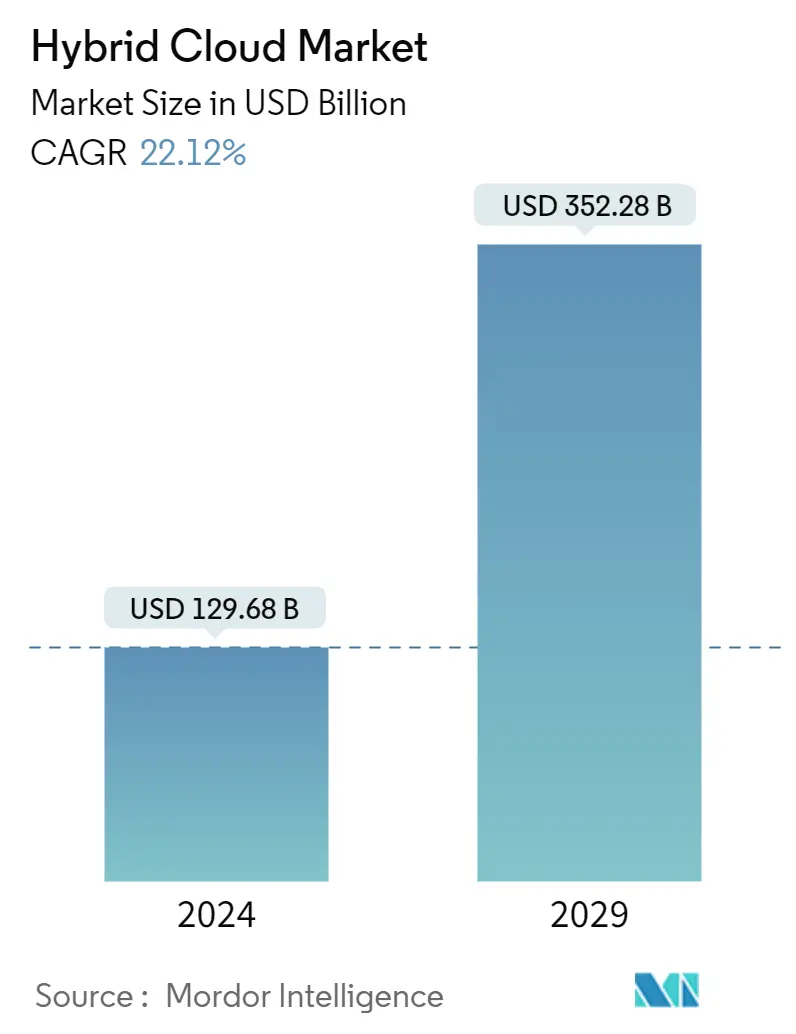Market Size of Hybrid Cloud Industry

| Study Period | 2019 - 2029 |
| Market Size (2024) | USD 129.68 Billion |
| Market Size (2029) | USD 352.28 Billion |
| CAGR (2024 - 2029) | 22.12 % |
| Fastest Growing Market | Asia Pacific |
| Largest Market | North America |
Major Players
*Disclaimer: Major Players sorted in no particular order |
Hybrid Cloud Market Analysis
The Hybrid Cloud Market size is estimated at USD 129.68 billion in 2024, and is expected to reach USD 352.28 billion by 2029, growing at a CAGR of 22.12% during the forecast period (2024-2029).
A major shift towards hybrid infrastructure services is apparent from the growth of cloud computing and industrial service, as well as a drop in traditional data center outsourcing. Compared to this, the conventional DCO market is shrinking, with investments in colocation and hosting as well as an increase in infrastructure utility services. This is expected to drive the shift to cloud infrastructure as a service and hosting. As a result of its advantages, hybrid cloud deployment continues to make up an increasing share of the cloud market.
- In recent years, the Hybrid Cloud market has experienced a strong overall growth in comparison to other cloud computing services. For organisations with a large amount of data and the need to process requests, it offers some benefits.
- When businesses need to free up local resources for more sensitive data or applications, using a hybrid cloud allows them to scale computing capacity and help eliminate the necessity of investing large amounts of capital in handling short term spikes in demand.
- Hybrid cloud enables businesses to increase their onpremises infrastructure up to the Public Cloud in response to any surge that may occur, without exposing entire data sets to Third Party Data Centres' access when there are fluctuations in demand for information and processing. The end users concerned about their data security and initially reluctant to adopt such a solution have been able to benefit from these developments.
- Instead of purchasing, programming and maintaining other resources or equipment on a continuous basis, businesses with cloud services are required to cover the temporary consumption of these resources. This will help to reduce the costs that businesses do not make a profit from.
- Furthermore, the adoption of Hyperscale cloud with benefits including data center modernization, consolidated operation, security and management, as well as application innovation is being pursued by public bodies. Such needs can be supported by the Hybrid Cloud. Moreover, cloud computing allows government organisations to cope with a cyclical demand or emergency needs without exceeding an excessive amount of hardware consumption.
- As enterprises continue migrating their applications and workloads to a hybrid multicloud environment, integration and management become more complex which might hamper market growth
- In the face of a COVID-19 pandemic, many countries around the world are imposing work from home due to public health safety concerns which have led to the need for remotely accessible working facilities. The growing demand for virtual services, the longer term potential to recast the government workforce, and the need to provide adaptive and dynamic regulatory models are the result of increased demand for virtual services, coupled with increasing citizen expectations for the delivery of these services.
Hybrid Cloud Industry Segmentation
A hybrid cloud refers to a model or approach in information technology (IT) infrastructure. A hybrid cloud integrates public cloud services, private cloud services, and on-premises infrastructure. It also provides orchestration, management, and application portability.
The hybrid cloud market is segmented by type (solutions, services), end-user industry (government & public sector, healthcare, BFSI, retail, information & communication technology, media & entertainment), and geography (North America, Europe, Asia Pacific, Latin America, Middle East & Africa). The market sizes and forecasts are provided in terms of value (USD) for all the segments.
| By Type | |
| Solutions | |
| Services |
| By End-user Industry | |
| Government and Public Sector | |
| Healthcare | |
| Banking, Finance, Services, and Insurance (BFSI) | |
| Retail | |
| Information and Communication Technology | |
| Media and Entertainment | |
| Other End-user Industries |
| By Geography | |
| North America | |
| Europe | |
| Asia Pacific | |
| Latin America | |
| Middle East and Africa |
Hybrid Cloud Market Size Summary
The hybrid cloud market is experiencing significant growth, driven by a shift towards hybrid infrastructure services and a decline in traditional data center outsourcing. This transition is fueled by the increasing adoption of cloud computing and industrial services, which offer businesses the flexibility to scale computing capacity without substantial capital investment. Hybrid cloud solutions enable organizations to expand their on-premises infrastructure to the public cloud, addressing surges in demand while maintaining data security. This model is particularly beneficial for sectors like banking, where critical processes are migrated to private clouds for enhanced security, while non-critical applications leverage public clouds for agility and cost efficiency. The COVID-19 pandemic has further accelerated the adoption of hybrid cloud solutions, as businesses and government organizations seek to meet the growing demand for virtual services and remote working capabilities.
North America is expected to hold a significant share of the hybrid cloud market, with companies in the region increasingly adopting hybrid models to enhance data security and productivity. The trend towards bring-your-own-device (BYOD) practices is contributing to this growth, as organizations seek to balance access to public cloud applications with the security of private cloud solutions. The pandemic has also prompted US enterprises to prioritize cloud adoption, leading to increased investments in hybrid cloud technologies. Major players in the industry, such as Cisco Systems Inc., Hewlett-Packard Enterprise Company, and Amazon Web Services, are focusing on expanding their global presence and enhancing their product offerings through strategic collaborations and acquisitions. The market's fragmentation is characterized by the presence of several key competitors, all vying to capture a larger share of the growing demand for hybrid cloud solutions.
Hybrid Cloud Market Size - Table of Contents
-
1. MARKET INSIGHTS
-
1.1 Market Overview
-
1.2 Industry Attractiveness - Porter's Five Forces Analysis
-
1.2.1 Bargaining Power of Suppliers
-
1.2.2 Bargaining Power of Buyers
-
1.2.3 Threat of New Entrants
-
1.2.4 Threat of Substitutes
-
1.2.5 Intensity of Competitive Rivalry
-
-
1.3 Technology Snapshot
-
-
2. MARKET SEGMENTATION
-
2.1 By Type
-
2.1.1 Solutions
-
2.1.2 Services
-
-
2.2 By End-user Industry
-
2.2.1 Government and Public Sector
-
2.2.2 Healthcare
-
2.2.3 Banking, Finance, Services, and Insurance (BFSI)
-
2.2.4 Retail
-
2.2.5 Information and Communication Technology
-
2.2.6 Media and Entertainment
-
2.2.7 Other End-user Industries
-
-
2.3 By Geography
-
2.3.1 North America
-
2.3.2 Europe
-
2.3.3 Asia Pacific
-
2.3.4 Latin America
-
2.3.5 Middle East and Africa
-
-
Hybrid Cloud Market Size FAQs
How big is the Hybrid Cloud Market?
The Hybrid Cloud Market size is expected to reach USD 129.68 billion in 2024 and grow at a CAGR of 22.12% to reach USD 352.28 billion by 2029.
What is the current Hybrid Cloud Market size?
In 2024, the Hybrid Cloud Market size is expected to reach USD 129.68 billion.

